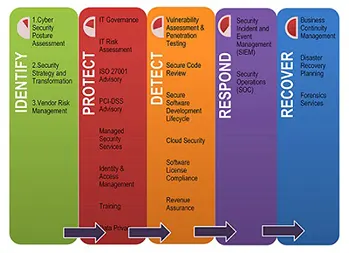Objective of Cybersecurity Disaster Recovery Plan: IT Security Methods
It is pretty sad that half of the organization could not recover from the cyber attacks. So, it is always important to take necessary precautions to overcome from this cyber crimes and provide information security. Are you and your organization prepared to face this cyber attack? If not, then do get panic. Here comes the blog with the complete cybersecurity disaster recovery plan templates to help you decide things before and after being faced by any cyber attacks. Data security or information security plan has greater importance in the proper functioning of an organization in this cyber era.
How Well Cybersecurity and Disaster Recovery Plan Fit in Together?
There has been a misconception among users that disaster recovery and cybersecurity recovery is the same. Well, it is not the same! The major role of disaster recovery of information is to ensure business continuity even after any catastrophe from any natural or man-made activities is caused. On the other hand, cybersecurity or information security protects the IT assets from the litany of threats that haunts the digital environment or after a data breach.
Both cybersecurity disaster recovery plan and information security plan strives to minimize the impact of unexpected incidents. If there are no proper plans gathered to beat any cyber attacks then the organization leaves itself vulnerable. Both these recovery strategies exhibit enough activities to restore the business operations as quick as possible. Besides this, they both are designed to offer limitless resilience power to minimize the occurrence of any such instance in the future.
Mark Testoni, President and CEO of SAP National Security Services quoted “The threats behavior within security recovery plans are more vigorous than within the disaster recovery.” For instance, Ransomware attacks like WannaCry are prone to destruct the IT assets and thus requires adequate information security recovery plans to analyze that how to respond to the new threats and risks in the cyber world.
Worried about Cyber Security Issues and Challenges?
Are you worried about losing your crucial data? Do not let any of the attacks breach or misuse your data. Most of the security experts recommend following multiple plans with suitable policies and procedure. See how to do cybersecurity disaster recovery plan for your organization without any loophole.
| Disaster Recovery Plan | Security Recovery Plan | |
|---|---|---|
| Primary Role | Ensures business continuity of any destructive attacks that has occurred | Protects IT assets after a breach |
| Mode of Response | Open communication with stakeholders, ensures fast recovery process | Provides a secret approach to collect the evidence and in analyzing the root cause |
| Strategic Differences | Quick and accurate recovery process | Protective approach to prevent future loss |
| Plan Management | A set of dedicated team devotes to focus any disaster recovery and plans it accordingly | Dedicated team keeps the update of any latest cybersecurity threats and manipulates the plans if required |
Best Cybersecurity Disaster Recovery Plan Template
Whether it is a classic virus or the latest network attack, any security threats can create a chaos and rule over us. Therefore, it is important to customize your data and integrate cybersecurity into the disaster recovery strategy.

1. Execute Tools and Controls for Layered Protection
- Take preventive measures like firewall to analyse and inspect the content that is received. Installing an antivirus can block viruses and vulnerabilities
- Make sure to control strictly on any changes and software uploads
- Strict Access control and audits to prevent any malicious software being attacks
- Timely monitoring to detect the issues early so as to take stringent actions
2. Proper Planning for the Recovery Phase
- Initiate an incident management roles and responsibilities
- Create a larger Business Continuity Plan and Cyber Incident Response Plan with a Crisis management strategy
- Ensure to create necessary arrangements for communication purpose
- Before the occurrence of any attacks or incidents, identify and fix gaps in crisis planning
- Based on the recent cyber attacks like Ransomware, generate and solve “What If” scenarios
- Seek constant improvement and keep a track and update on the recent cyber attacks
3. Create a Document for Improved Recovery
- Procedures, metrics tracking, etc. should be documented for advanced response times and recovery
- Create and develop diagrams of equipment and infrastructure
- Well-maintained assets and systems inventory like copies of agreements with vendors and providers
- Gather regulatory compliance information like who, when, how, which will help to fix issues in the event of a data breach
- Prioritize the crucial applications, which needs to be recovered first
- Steps to resolve Cyber Attacks on Schools
- Useful Tips to Protect Hospitals & Healthcare from Ransomware Attacks
Closing Thoughts
It’s an evolving business world where things keep on changing. Therefore, the organization must take the necessary actions to mitigate the risk due to cybersecurity threats and disaster. With the recent increase of cyber risks and information breach, it has become important for the organization to dedicate more resources to prevent such attacks to provide proper information security. In such instance, the cybersecurity disaster recovery plan plays a vital role. Hence, make a practice to manage the above-discussed strategies across different teams within the organization. This will bring an environment to control the risk with the ever-growing cyber attacks.

